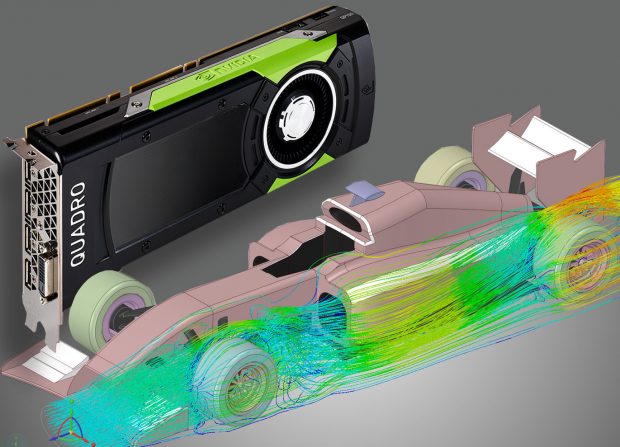Processing and Analysis Power for Engineering Ingenuity

The NVIDIA Quadro GP100 GPU (graphics processing unit) is designed to handle compute-intensive engineering analysis and visualization workflows. Image courtesy of NVIDIA Corp.
Latest News
October 19, 2017
Imagine Gordon Gekko saying speed is good about workstations. But he might add that speed alone without the simulation power to clarify, cut through and capture the essence of designs is ingenuity underused. The combined effort to match the powers of GPUs (graphics processing units) and simulation on engineering workstations and HPC (high-performance computing) clusters is what makes the NVIDIA-ANSYS collaboration so interesting. Today’s Check it Out link gives you the chance to learn what this collaboration means for you.
 The NVIDIA Quadro GP100 GPU (graphics processing unit) can speed up compute-intensive ANSYS fluid dynamics, structural, electromagnetics and design discovery engineering simulation workflows. Quadro GPU image courtesy of NVIDIA Corp. Race car screen capture courtesy of ANSYS Inc.
The NVIDIA Quadro GP100 GPU (graphics processing unit) can speed up compute-intensive ANSYS fluid dynamics, structural, electromagnetics and design discovery engineering simulation workflows. Quadro GPU image courtesy of NVIDIA Corp. Race car screen capture courtesy of ANSYS Inc.Two technologies headline the upcoming “Increasing Your ANSYS Simulation Throughput” webinar that NVIDIA, ANSYS and tech consultancy SimuTech Group have developed. The first is NVIDIA’s Pascal-class GP100 GPU with its CUDA-enabled 3584 parallel computing cores. The second is a group of ANSYS simulation solutions that includes its mechanical and electronics tool suites, the Fluent CFD (computational fluid dynamics) tool chest and its new design exploration tool Discovery Live.
For brevity’s sake, the GP100 is a workstation-size GPU that is similar to an NVIDIA Tesla GPU for data center servers. The GP100 is engineered to handle demanding simulation, rendering, virtual reality and visualization workflows and data sets. A secret sauce is NVIDIA’s CUDA programming model. It’s intended to enable application developers to exploit the GPU’s parallel-processing potential, increasing throughput dramatically.
ANSYS’ solutions can leverage the GP100’s power, and that is the focus of this high-level webinar. For you designers steeped in concept development, you’ll see how Discovery Live with its new CUDA-compliant fluids, structural and thermal solvers taps the GP100’s potential to give you direct geometry editing, solver results and visualizations in near real time.
For analysts, the speed of complex, sizable jobs running on GP100-equipped workstations and on HPC clusters will be demonstrated. The demo simulations will be augmented with realistic use cases to help you visualize your own workflows with this performance potential.
In addition, the presentation will include explanations of how this all works and its effect on the future of CAE and design. You’ll get reports from industry colleagues using the NVIDIA-ANSYS combination already, and you’ll get metrics showing the potential throughput increase you could realize.
Power and speed be hands and feet, wrote Emerson. But power and speed can be your mind and ingenuity, too. The “Increasing Your ANSYS Simulation Throughput” webinar will show you how. It airs live at 10 a.m. (PST), next Tuesday, October 24. Hit today’s Check It Out link to reserve your seat.
Thanks, Pal. – Lockwood
Anthony J. Lockwood
Editor at Large, DE
Subscribe to our FREE magazine, FREE email newsletters or both!
Latest News
About the Author
Anthony J. Lockwood is Digital Engineering’s founding editor. He is now retired. Contact him via [email protected].
Follow DE







 Dear DE Reader:
Dear DE Reader: